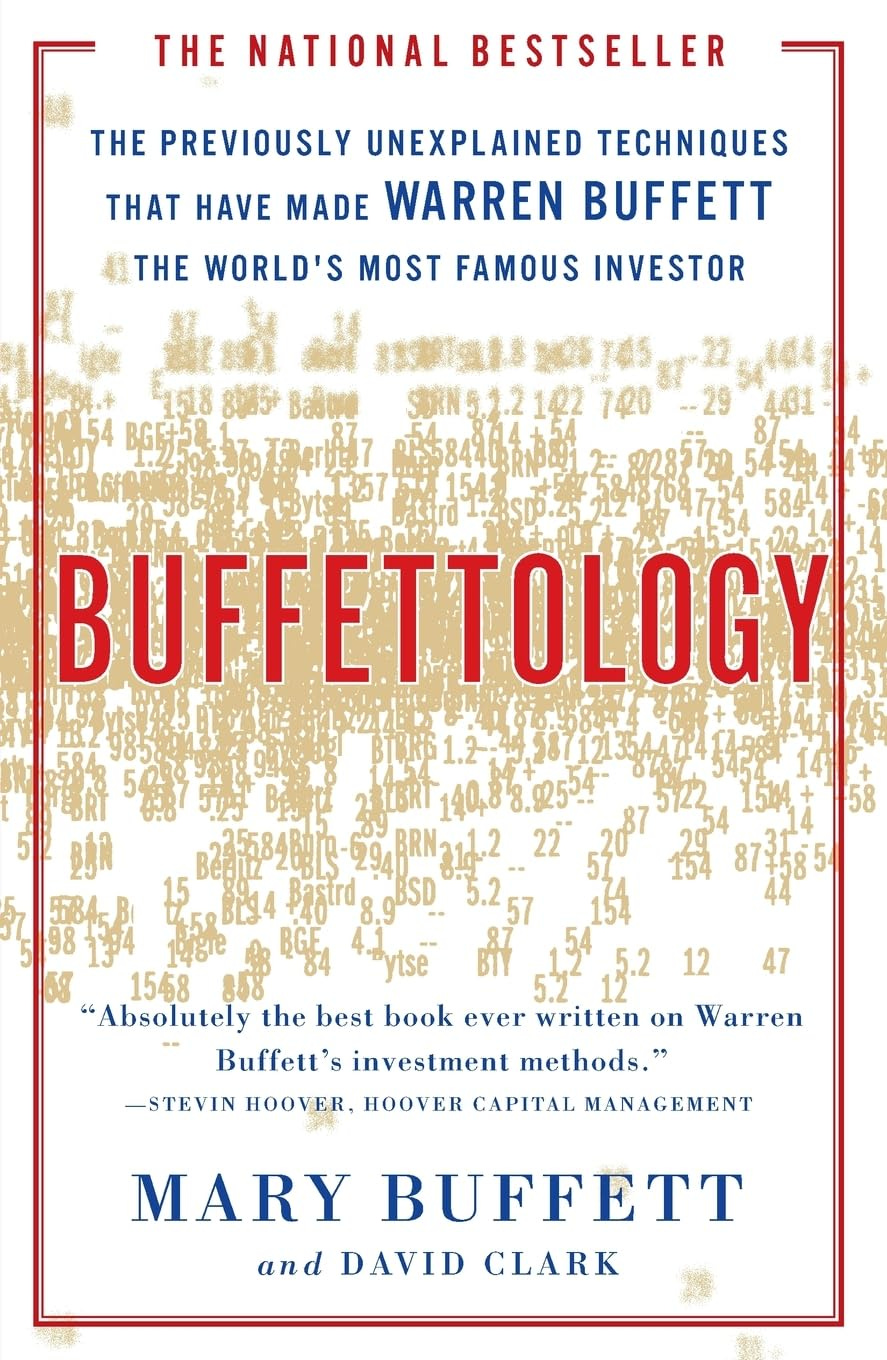Dear readers,
Today I bring you a new section in the blog: Book Reviews.
One of the best, and more important things I do since I started investing about 6 years ago is the habit of reading.
I read book about many subjects, from finance books to biographies, essays, etc. This blog serves a logbook of a passionate trip. In this trip, investing in companies is just part of the journey.
Reading books is an essential part of the trip. Not only reading about the greatest investors, but also about any other topic related or not with my investments.
The main purpose of this section is to publish the most important lessons I learned from each book, so they are available to revisit them over time.
I hope you enjoy it!
Buffettology
An interesting book, but a little bit outdated.
Rating (/5): ⭐⭐⭐
Difficulty: Low
Topic: Investments
Author: Mary Buffett and David Clark
Year: 1997
Buffettology is a book that aims to summarize Warren Buffett’s main criteria when selecting investments. The problem I find with the book is that its not the own vision of Warren Buffet, as the book was written by Mary Buffett, a former daughter-in-law of Warren Buffett and has built her career as a writer, speaker, and educator, specializing in interpreting and teaching his value investing principles.

As many books that describe the investment from other people, this book only focuses on some attributes of the companies. You won’t find other things like learning from mistakes, etc. But overall, its a good book to review critical concepts such as what makes a business better than others?
In my review, I will focus in three chapters of the book, that were specially important and interesting.
Valuing a business
The book introduces an interesting concept regarding how to value a business. A business is similar to buying a bond:
The price you pay will determine the rate of return you will get in the future
Same as a bond, there are coupons every certain time, in the form of earnings
The earnings yield, which is the earnings per share (EPS) divided by the price paid, will give you a proxy of the returns you can get in the future.
The important thing is to understand how these earnings might evolve in the future. Several key concepts are:
The quality of the business. Are these earnings stable and growing?
Is the company retaining these earnings to invest for additional growth?
The main problem I find with this formula is that the book focuses on earnings per share and not free cash flow.
Cash generation is what matters, but the book only focuses on EPS. Bear in mind that EPS is an accounting metric that doesn’t take into account the cash generation (working capital, investments, etc.).
Finding Excellent Business
Chapter 16 of the book is probably the most interesting. It provides with 9 questions to determine if a business is an excellent business. Its a book clearly dedicated to high quality companies, meaning companies with a ver strong market positioning earning above-average returns.
I will list all the questions and give my modest opinion on these.
1. Does the business have an identifiable consumer monopoly?
Companies operating in monopolies or quasi-monopolies are businesses with a very strong moat. This is the case for companies like AMSL or Airbus in Europe, S&P/Moody’s in the US. These companies have just a few competitors, and they own the market.
If you are considering to invest only in high quality companies, this question is mandatory. If not, this question is important, are we can split into two sub-questions:
Is the market an oligopoly with just a few companies leading the market? EssilorLuxottica is the clear market leader in a very fragmented market. This provides them the status of a quasi-monopoly as they are 2-3x bigger that the second largest players.
Is the company the market leader? I prefer market leaders rather than challengers, but always depends on the individual situation
Consumer monopolies, or oligopolies provide strong competitive advantages. Even in industries like body-in-white auto components, you find companies that own a very high market share. These companies, tend to outperform the worst companies.
2. Are the earnings of the company strong, and showing an upward trend?
What Warren Buffett looks for is companies with a steady upward trend in their profits. The book focuses only on companies which earnings increase every year. These are really great businesses.
A clear example is LVMH:
However, as a value investor, you may find good investment opportunities in companies facing difficulties, or in cyclical companies:
Companies facing difficulties: I invested in PayPal, a business that had declining net profit during two years, and the stock plummeted. I thought it was a good investment, as the new CEO had a strong view on how to turnaround the business. The investment is up +30%. Other cases might take longer, but there are opportunities in turnaround companies.
Cyclical businesses: The automotive sector is at the lowest part of the cycle. I think its a good opportunity to buy companies like Porsche at ~13x FCF.
Overall, this question is really great, and its a good metric for investors to find great business. However:
I will focus more on FCF rather than earnings per share
Won’t exclude from my investment scope companies facing some short-term difficulties
3. Is the company conservatively financed?
This is a critical point. I don’t invest in highly indebted companies.
By highly indebted I interpret companies with a Net Debt / EBITDA ratio above 2x with an insufficient cash flow generation to reduce net debt over the next years.
If you have a company with a high leverage, you might loose a lot of money, or earn a lot. Leverage increases both returns or losses. Many times, this is very difficult to forecast. So why taking the risk if you are not an expert in the subject?
In this case, I agree a 100% with the author of the book.
4. Does the business consistently earn a high rate of return on shareholders’ equity?
The book says that Warren Buffet only looks for companies earning a ROE (return on Equity) above 15%. It makes sense, in orden to ensure that the profits reinvested by the company earn a high return, above their cost of capital.
This book is from 1997. Almost 30 years later, investors now focus on ROIC (Return on Invested Capital), which is slightly more complex to calculate, but the concept is still similar. You may also find it at ROCE (Return on Capital Employed). All these metrics are similar and measure the returns on the capital invested by the company.
The book simplifies saying 15% ROE companies, because this will normally lead to companies earning returns above their cost of capital. Given ROIC is a better measure, the ROIC needs to be compared with the WACC (cost of capital of the company).
A company generates value by earning a ROIC > WACC
The best book you can read on this topic is Valuation: Measuring and Managing the Value of Companies (Wiley Finance).
Additionally, you can also read Michael J. Mauboussin papers. They are free and available in his website! https://www.michaelmauboussin.com/
5. Does the business get to retain its earnings?
Companies that distribute high amounts of dividends means that they are not reinvesting all the profits for growth.
For investors, is better a company that reinvest their profits at high rate of return, rather than distributing dividends.
The reason? Government will tax all dividends.
Example:
Company generates 100 in profits and reinvest all of them at 10% return. At the end of the year, the 100 will be 110.
The investor receives the 100 in profits as dividends. Government will tax, lets say, 20%, so the investor receives 80. After earning the same 10%, the result will be 88 at the end of the year.
Avoid taxes, they destroy value.
Same with stocks, the more you buy and sell, the higher the impact of taxes. Its better to compound rather than paying taxes.
6. How much does the business have to spend on maintaining current operations?
Avoid business that need to reinvest high amounts of capital to stay in business (not the same as investing for growth).
As an example, telecommunications companies have been investing heavily in fiber and 5G just to stay in the business. The result? Very poor results for investors, including heavy permanent losses.
I stay out of those business.
7. Is the company free to reinvest retained earnings in new opportunities or share buybacks? How good the management is in doing it?
If a company has excess cash after investing in growth, the management can then reinvest in M&A or in share buybacks.
This allows the company to continue growing or reducing the share count without issuing debt.
However, its critical that the management has strong discipline and don’t invest or repurchase its shares at the top of the cycle.
8. Has the company earnings power?
Companies with strong market positioning have earnings power. They can raise their prices every year, and demand won’t be affected.
These are high quality business with very deep moats.
I’m invested in LVMH, a company whose main brands Louis Vuitton and Christian Dior can raise prices every year. Actually, the more they raise their prices, the better as its a luxury product.
9. Will the value added by retained earnings increase the market value of the company?
The question refers to companies which stock price is not correlated to earnings. He wants to avoid those speculative bets.
I believe the same, and I avoid FOMO (fear of missing out), and don’t acquire companies with a non-sense valuation. An example is Palantir, a company trading at 200x net profit.
Lets assume Palantir will be a great high quality company trading at 30x PE in the future:
Company currently trades at 200x EPS 2026. At a share price of $65, it implies an EPS of $0.32
If company in the future trades at P/E ratio of 30x, it means that the company needs to generate an EPS of $2.2, for you not to loosing money ($65 per share dividend 30x P/E). This implies that earnings need to increase by 7x during the next years
It can happen, but how certain are you?
If we use 2024 figures, EPS needs to increase by 10x, even more challenging
Final idea: The main three types of businesses
The book highlights these three types of business in which investors should focus:
Businesses that make products that are consumed fast, with branding power and merchants need them to survive. Yes, the author is talking about Coca Cola.
Every supermarket needs to sell it, and its consumption is fast, meaning the company generates repetitive sales in short periods of time.
In my watchlist I have PepsiCo, a company selling Pepsi or Doritos, which are products that every supermarket needs
Communications businesses that provide a repetitive service manufacturer for companies that want to advertise their brand or products. Although the book is quiet outdated, as they talk about newspapers, the main example that we could use is Google or Meta. Companies that are necessary to advertise your products.
Businesses with repetitive consumer services that people and companies needs every time. Here we are talking about American Express. In my case, I have invested in Visa, a company with a huge moat:
Every bank issuing credit cards needs in order to process payments
Consumers need credit cards (either credit or debit), as they make life easier
All merchants need to be in the Visa network if they want to process payments
Last word
Overall, its a great book. I don’t give more starts as it is quiet outdated, and because I think sometimes might be generic. But if you are starting investing in companies, its a really good option.
The checklist I discussed about what makes a company an excellent business is very interesting and I will make sure that my investments are tick most of the boxes of this checklist.
What next?
I’m currently reading the Elon Musk biography written by Walter Isaacson (same author as Steve Jobs bio). So far, I really interesting book, however its a 600+ book, so it might take some time to read it. But so far, I’m enjoying a lot and I really recommend it.
Thank you for reading this review
European Value Investor








Thanks for the review.
One comment on point 9 - I always understood Buffett's 1 Dollar test as a quick test to see if the market recognizes the value of retaining earnings - meaning that if a company retains earnings and grows but the market value does not go up by at least that amount, the company is "out" (or a deep investigation is needed as to why the market doesn't reward it). https://www.safalniveshak.com/warren-buffetts-dollar-test/
This means that the test looks for companies where the market price _does_ correlate with retained earnings (and those should increase earnings in the future as they are reinvestments into the business).
I write this as I interpreted your statement about "avoiding FOMO" to be meaning that the intention of the test is the opposite: to avoid overpriced securities, i.e. those that have gone up way more than retained earnings did. Obviously, we don't want FOMOing into an overpriced security, but if I interpret your statement correctly you seek companies that are undervalued that have been reinvesting but the market did not at least recognize the value of the retained earnings.